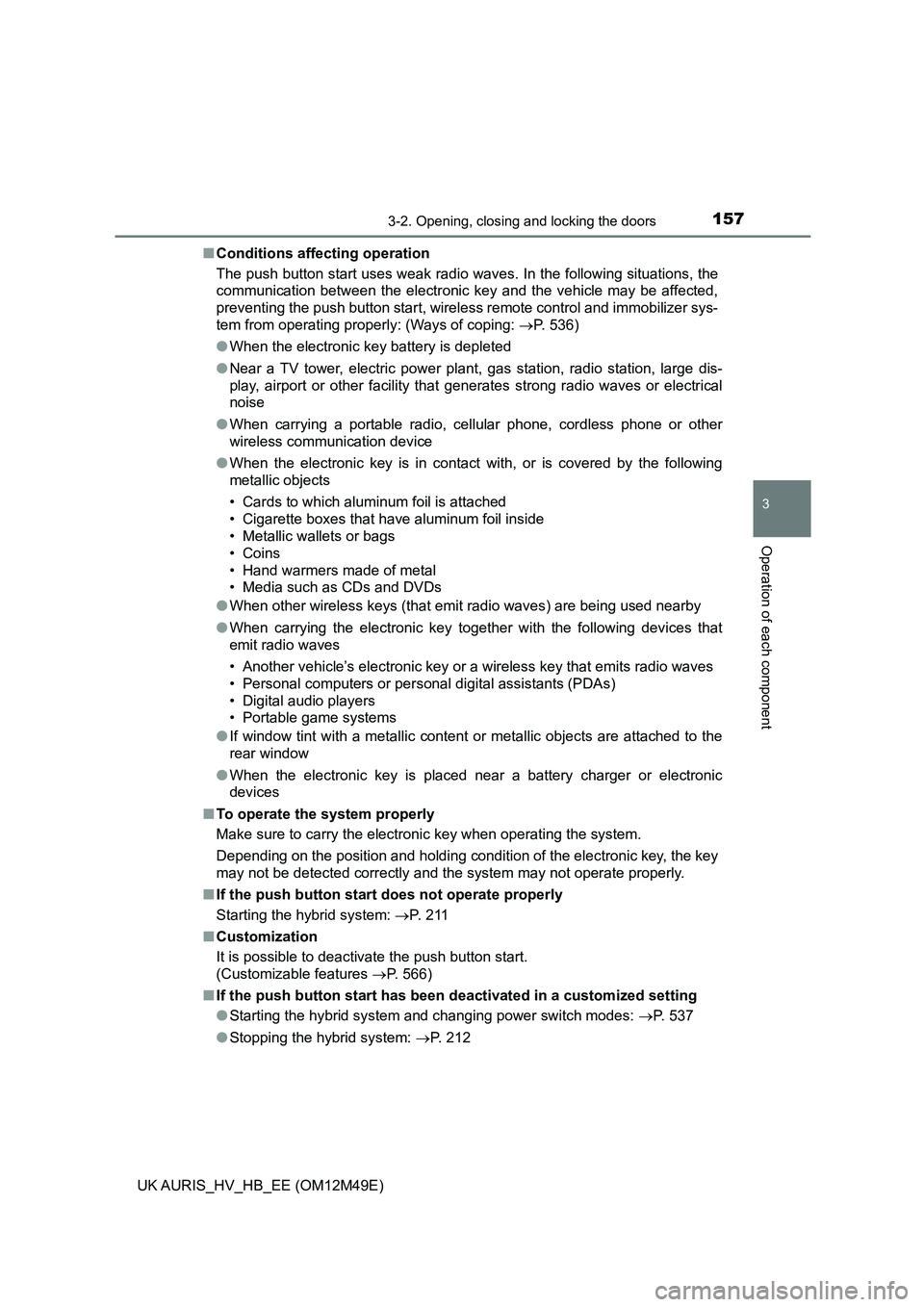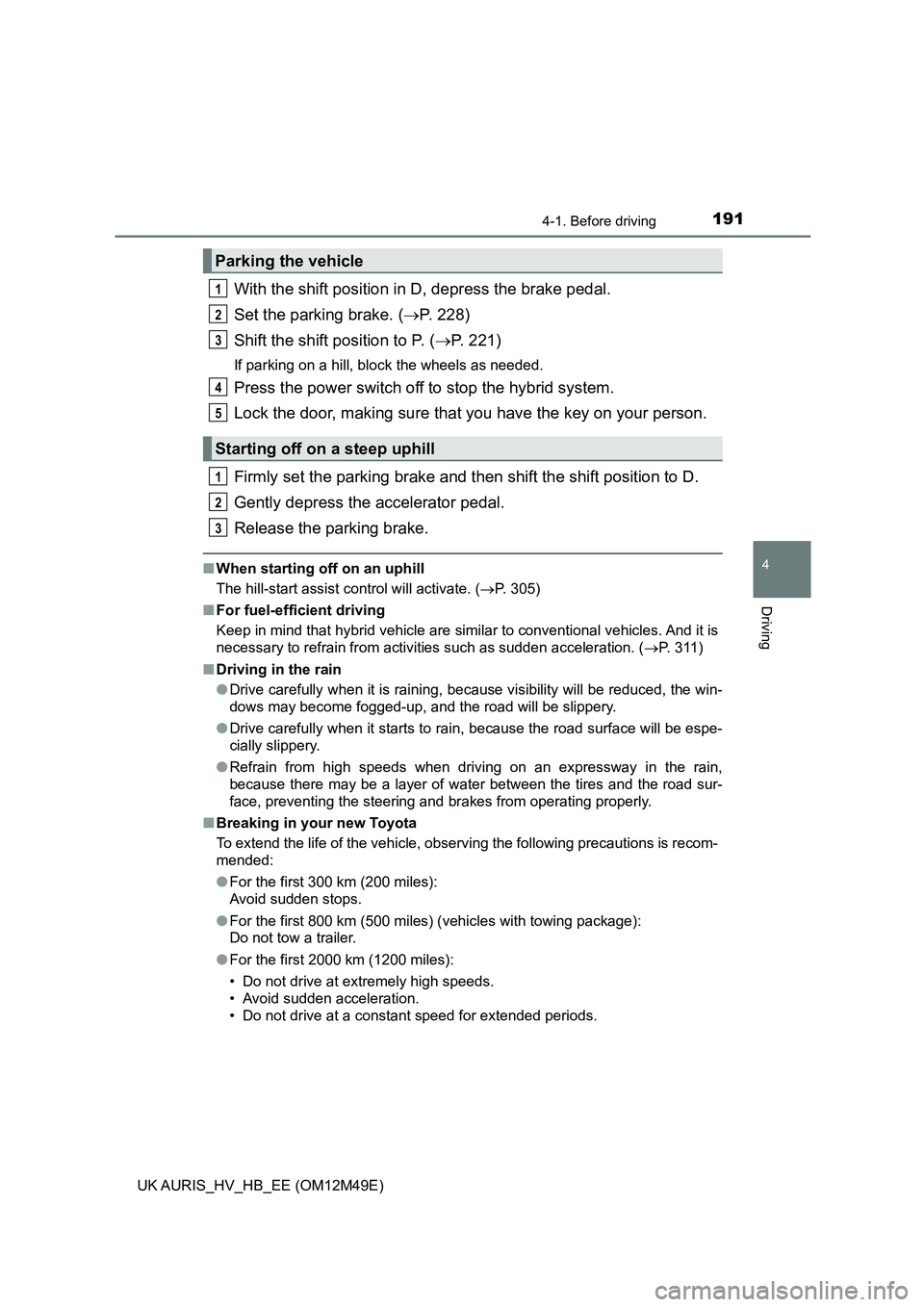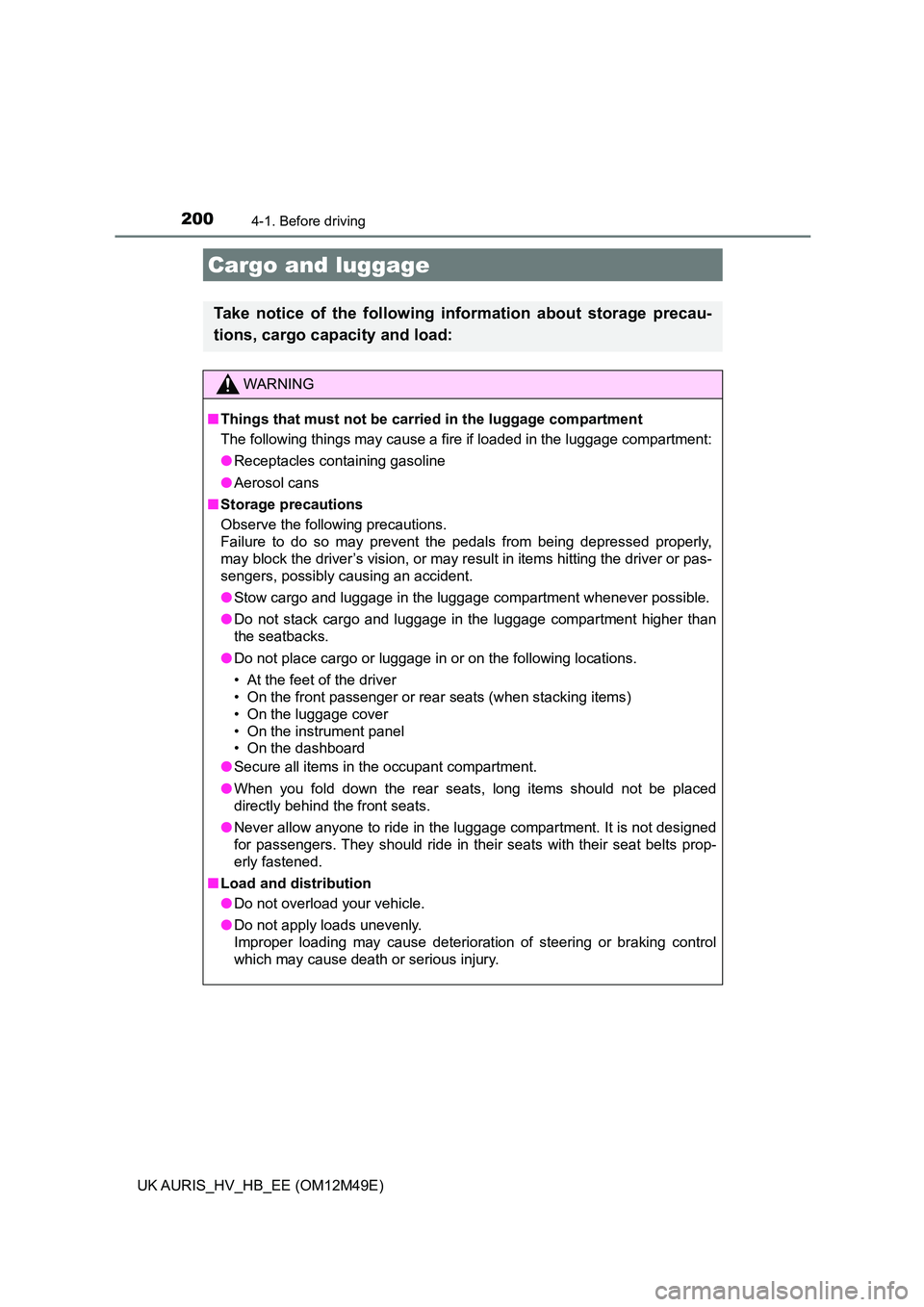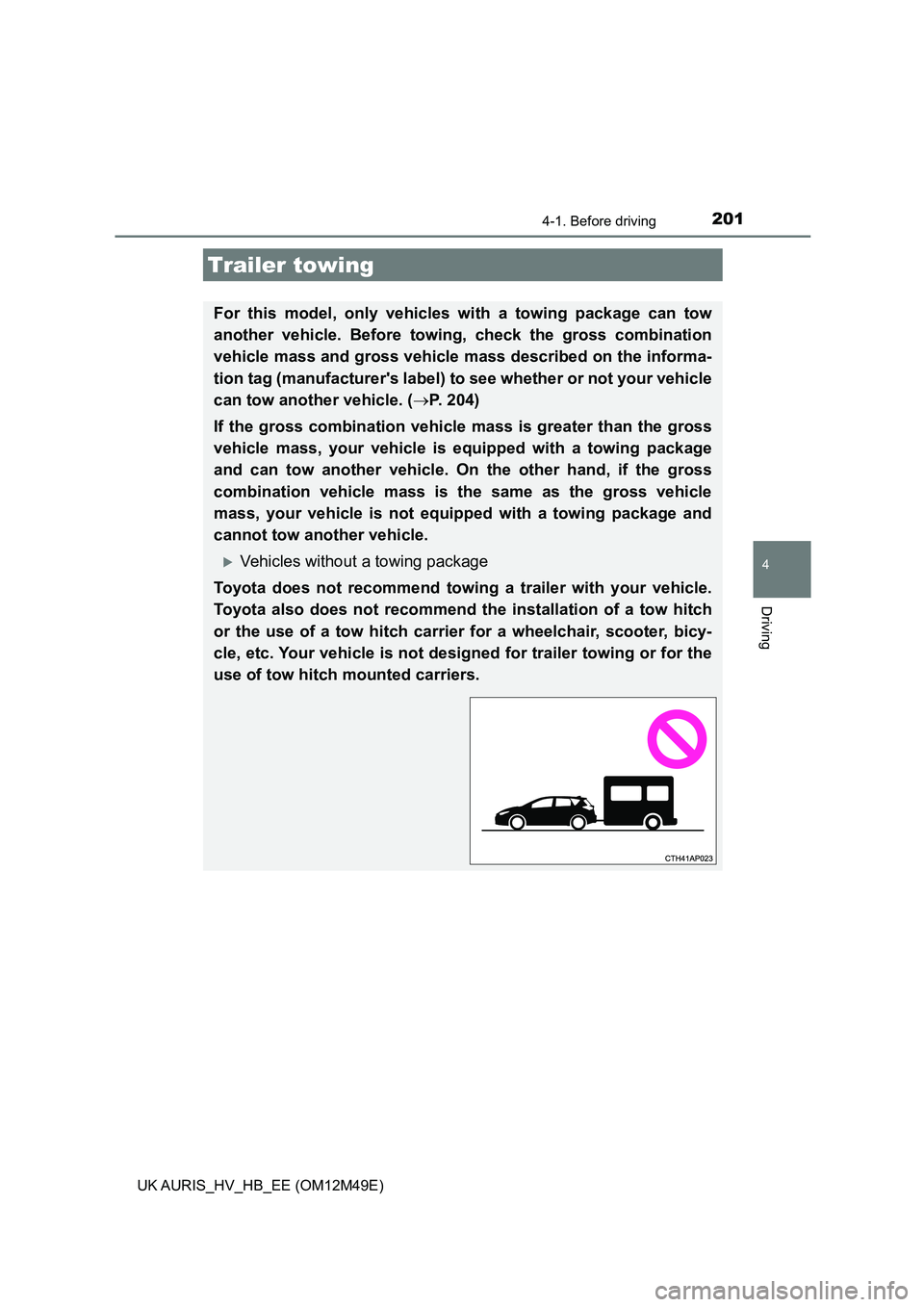Page 157 of 592

1573-2. Opening, closing and locking the doors
UK AURIS_HV_HB_EE (OM12M49E)
3
Operation of each component
■Conditions affecting operation
The push button start uses weak radio waves. In the following situations, the
communication between the electronic key and the vehicle may be affected,
preventing the push button start, wireless remote control and immobilizer sys-
tem from operating properly: (Ways of coping: P. 536)
● When the electronic key battery is depleted
● Near a TV tower, electric power plant, gas station, radio station, large dis-
play, airport or other facility that generates strong radio waves or electrical
noise
● When carrying a portable radio, cellular phone, cordless phone or other
wireless communication device
● When the electronic key is in contact with, or is covered by the following
metallic objects
• Cards to which aluminum foil is attached
• Cigarette boxes that have aluminum foil inside
• Metallic wallets or bags
• Coins
• Hand warmers made of metal
• Media such as CDs and DVDs
● When other wireless keys (that emit radio waves) are being used nearby
● When carrying the electronic key together with the following devices that
emit radio waves
• Another vehicle’s electronic key or a wireless key that emits radio waves
• Personal computers or personal digital assistants (PDAs)
• Digital audio players
• Portable game systems
● If window tint with a metallic content or metallic objects are attached to the
rear window
● When the electronic key is placed near a battery charger or electronic
devices
■ To operate the system properly
Make sure to carry the electronic key when operating the system.
Depending on the position and holding condition of the electronic key, the key
may not be detected correctly and the system may not operate properly.
■ If the push button start does not operate properly
Starting the hybrid system: P. 211
■ Customization
It is possible to deactivate the push button start.
(Customizable features P. 566)
■ If the push button start has been deactivated in a customized setting
● Starting the hybrid system and changing power switch modes: P. 537
● Stopping the hybrid system: P. 212
Page 175 of 592
1753-3. Adjusting the seats
UK AURIS_HV_HB_EE (OM12M49E)
3
Operation of each component
Move the front seats forward. (P. 173)
Stow the rear armrest. (if equipped) ( P. 408)
Stow the rear center seat belt
buckle.
Lower the head restraints to the lowest position. ( P. 177)
Pull the seatback lock release
lever and fold the seatback
down.
Each seatback may be folded sep-
arately.
Rear seats
The seatbacks of the rear seats can be folded down.
Folding down the rear seatbacks
1
2
3
4
5
Page 177 of 592
1773-3. Adjusting the seats
UK AURIS_HV_HB_EE (OM12M49E)
3
Operation of each component
Vertical adjustment
Up
Pull the head restraints up.
Down
Push the head restraint down while
pressing the lock release button.
■ Removing the head restraints
■ Adjusting the height of the head restraints
■ Adjusting the rear seat head restraint
Always raise the head restraint one level from the stowed position when
using.
Head restraints
Head restraints are provided for all seats.
Lock release button
1
2
Pull the head restraint up while pressing
the lock release button.
Make sure that the head restraints are
adjusted so that the center of the head
restraint is closest to the top of your ears.
Lock release button
Page 189 of 592

189
4Driving
UK AURIS_HV_HB_EE (OM12M49E)
4-1. Before driving
Driving the vehicle ............. 190
Cargo and luggage ............ 200
Trailer towing ..................... 201
4-2. Driving procedures
Power (ignition) switch ....... 211
EV drive mode ................... 217
Hybrid transmission ........... 219
Turn signal lever ................ 227
Parking brake .................... 228
4-3. Operating the lights
and wipers
Headlight switch ................ 229
Fog light switch .................. 235
Windshield wipers
and washer ...................... 237
Rear window wiper
and washer ...................... 241
4-4. Refueling
Opening the fuel tank
cap ................................... 243
4-5. Toyota Safety Sense
Toyota Safety Sense ......... 246
PCS
(Pre-Crash Safety
system) ............................ 252
LDA
(Lane Departure Alert) ..... 265
Automatic High Beam ........ 270
RSA (Road Sign Assist)..... 274
4-6. Using the driving
support systems
Cruise control..................... 280
Toyota parking
assist-sensor ................... 284
Simple-IPA
(Simple-Intelligent
Parking Assist)................. 291
Driving assist systems ....... 305
4-7. Driving tips
Hybrid vehicle driving
tips ................................... 311
Winter driving tips .............. 314
Page 191 of 592

1914-1. Before driving
UK AURIS_HV_HB_EE (OM12M49E)
4
Driving
With the shift position in D, depress the brake pedal.
Set the parking brake. ( P. 228)
Shift the shift position to P. ( P. 221)
If parking on a hill, block the wheels as needed.
Press the power switch off to stop the hybrid system.
Lock the door, making sure that you have the key on your person.
Firmly set the parking brake and t hen shift the shift position to D.
Gently depress the accelerator pedal.
Release the parking brake.
■ When starting off on an uphill
The hill-start assist control will activate. ( P. 305)
■ For fuel-efficient driving
Keep in mind that hybrid vehicle are similar to conventional vehicles. And it is
necessary to refrain from activities such as sudden acceleration. ( P. 311)
■ Driving in the rain
● Drive carefully when it is raining, because visibility will be reduced, the win-
dows may become fogged-up, and the road will be slippery.
● Drive carefully when it starts to rain, because the road surface will be espe-
cially slippery.
● Refrain from high speeds when driving on an expressway in the rain,
because there may be a layer of water between the tires and the road sur-
face, preventing the steering and brakes from operating properly.
■ Breaking in your new Toyota
To extend the life of the vehicle, observing the following precautions is recom-
mended:
● For the first 300 km (200 miles):
Avoid sudden stops.
● For the first 800 km (500 miles) (vehicles with towing package):
Do not tow a trailer.
● For the first 2000 km (1200 miles):
• Do not drive at extremely high speeds.
• Avoid sudden acceleration.
• Do not drive at a constant speed for extended periods.
Parking the vehicle
Starting off on a steep uphill
1
2
3
4
5
1
2
3
Page 199 of 592

1994-1. Before driving
UK AURIS_HV_HB_EE (OM12M49E)
4
Driving
NOTICE
■If you get a flat tire while driving
A flat or damaged tire may cause the following situations. Hold the steering
wheel firmly and gradually depress the brake pedal to slow down the vehi-
cle.
● It may be difficult to control your vehicle.
● The vehicle will make abnormal sounds or vibrations.
● The vehicle will lean abnormally.
Information on what to do in case of a flat tire ( P. 507, 519)
■ When encountering flooded roads
Do not drive on a road that has flooded after heavy rain etc. Doing so may
cause the following serious damage to the vehicle:
● Engine stalling
● Short in electrical components
● Engine damage caused by water immersion
In the event that you drive on a flooded road and the vehicle is flooded, be
sure to have any authorized Toyota dealer or repairer, or another duly quali-
fied and equipped professional check the following:
● Brake function
● Changes in quantity and quality of engine oil, hybrid transmission fluid,
etc.
● Lubricant condition for the bearings and suspension joints (where possi-
ble), and the function of all joints, bearings, etc.
If the P position control system is damaged by flooding, it may not be possi-
ble to shift the shift position to P, or from P to other positions. When the shift
position cannot be changed from P to any other position, the front wheels
will lock, and you will be unable to tow the vehicle with the front wheels on
the ground, as the front wheels may be locked. In this case, transport the
vehicle with both front wheels or all four wheels lifted.
Page 200 of 592

2004-1. Before driving
UK AURIS_HV_HB_EE (OM12M49E)
Cargo and luggage
Take notice of the following information about storage precau-
tions, cargo capacity and load:
WARNING
■ Things that must not be carried in the luggage compartment
The following things may cause a fire if loaded in the luggage compartment:
● Receptacles containing gasoline
● Aerosol cans
■ Storage precautions
Observe the following precautions.
Failure to do so may prevent the pedals from being depressed properly,
may block the driver’s vision, or may result in items hitting the driver or pas-
sengers, possibly causing an accident.
● Stow cargo and luggage in the luggage compartment whenever possible.
● Do not stack cargo and luggage in the luggage compartment higher than
the seatbacks.
● Do not place cargo or luggage in or on the following locations.
• At the feet of the driver
• On the front passenger or rear seats (when stacking items)
• On the luggage cover
• On the instrument panel
• On the dashboard
● Secure all items in the occupant compartment.
● When you fold down the rear seats, long items should not be placed
directly behind the front seats.
● Never allow anyone to ride in the luggage compartment. It is not designed
for passengers. They should ride in their seats with their seat belts prop-
erly fastened.
■ Load and distribution
● Do not overload your vehicle.
● Do not apply loads unevenly.
Improper loading may cause deterioration of steering or braking control
which may cause death or serious injury.
Page 201 of 592

2014-1. Before driving
UK AURIS_HV_HB_EE (OM12M49E)
4
Driving
Trailer towing
For this model, only vehicles with a towing package can tow
another vehicle. Before towing, check the gross combination
vehicle mass and gross vehicle mass described on the informa-
tion tag (manufacturer's label) to see whether or not your vehicle
can tow another vehicle. ( P. 204)
If the gross combination vehicle mass is greater than the gross
vehicle mass, your vehicle is equipped with a towing package
and can tow another vehicle. On the other hand, if the gross
combination vehicle mass is the same as the gross vehicle
mass, your vehicle is not equipped with a towing package and
cannot tow another vehicle.
Vehicles without a towing package
Toyota does not recommend towing a trailer with your vehicle.
Toyota also does not recommend the installation of a tow hitch
or the use of a tow hitch carrier for a wheelchair, scooter, bicy-
cle, etc. Your vehicle is not de signed for trailer towing or for the
use of tow hitch mounted carriers.